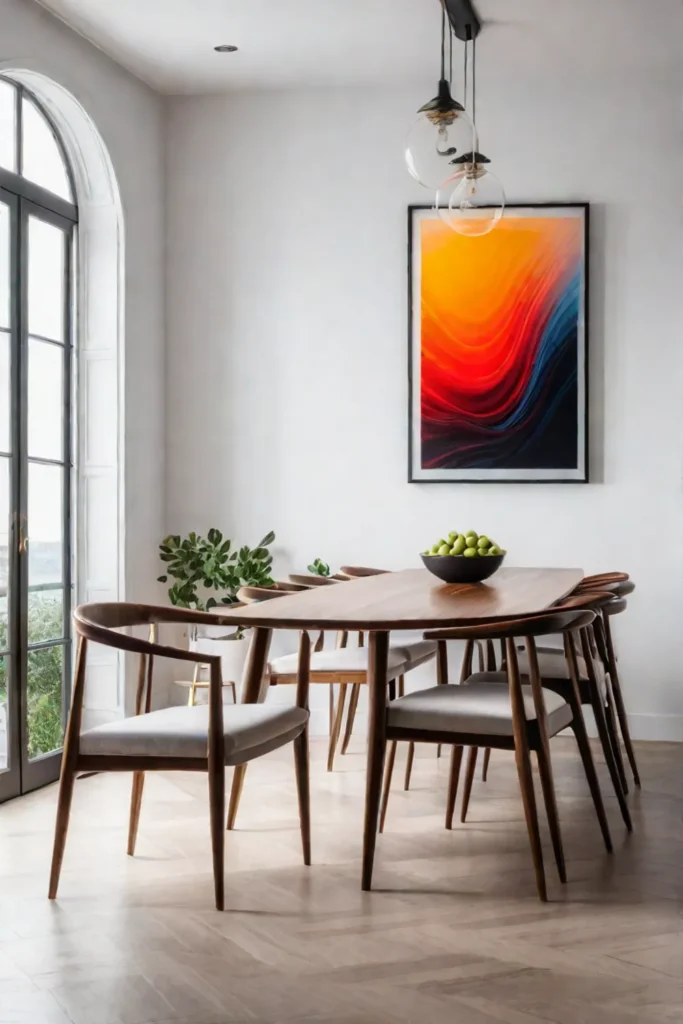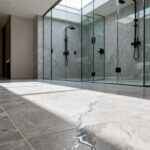Picture this: you’ve spent countless hours meticulously curating the perfect dining room, from the exquisite table settings to the carefully selected furniture pieces. But something feels amiss, a missing ingredient that could elevate the space from a mere functional area to a captivating, artful sanctuary. The answer, dear friends, lies in the power of wall decor.

And what better way to create an unforgettable dining experience than crafting an environment that ignites the senses and stirs the soul?
The Canvas Awaits: Artwork as a Focal Point
Imagine stepping into a dining room where the walls come alive with vibrant hues, intricate brushstrokes, and stories waiting to be told. Artwork is a powerful tool for transforming a dining space, adding visual interest, and reflecting your unique style. From paintings and photographs to sculptures and tapestries, the right artwork can elevate the room and create a captivating focal point.
Choosing the Right Scale, Medium, and Style
When selecting artwork for your dining room, consider the space’s scale and the artwork’s medium and style. A large-scale painting may be more suitable for a spacious dining room, while a series of smaller pieces can create a cohesive gallery wall in a more intimate setting. Mediums such as oil, watercolor, or digital art can add texture and depth to the room, while the style should reflect your taste and the overall design aesthetic.

Incorporating a Cohesive Theme or Color Palette
To create a harmonious and visually appealing space, consider incorporating a theme or color palette that ties the artwork together. This can be achieved by selecting pieces with similar colors or choosing artwork with a common subject or style. For instance, a collection of nature-inspired pieces could bring a serene, earthy vibe to your dining room, while a bold, abstract series could infuse the space with energy and dynamism.
Balancing Artwork with Other Design Elements
When incorporating artwork into your dining room, be mindful of balancing it with other design elements. Consider the placement of furniture, lighting, and other decorative accents to ensure that the artwork is not overpowered or lost in the space. A well-curated arrangement will create a harmonious symphony of visual delights, where each element complements and enhances the other.

Did you know that the use of artwork in dining rooms dates back to ancient civilizations, where it was used to showcase wealth and cultural sophistication? Studies have also shown that artwork can have a positive impact on mood and cognitive function, enhancing the overall dining experience.
Reflections of Elegance: The Versatility of Mirrors
Mirrors are not merely functional pieces; they are versatile and practical additions to any dining room. They serve both aesthetic and practical purposes. They can visually expand the space, reflect light, and create the illusion of depth, all while enhancing the overall design.

Choosing the Right Size, Shape, and Frame
Consider the size, shape, and frame when selecting mirrors for your dining room. A large, rectangular mirror can create the illusion of a larger space, while a round or oval mirror can add a softer, more organic touch. The frame should complement the existing decor and style of the dining room, whether it’s modern, traditional, or eclectic.
Strategically Placing Mirrors
Mirrors can be strategically placed to maximize their impact in the dining room. For example, placing a mirror opposite a window can reflect natural light and create a brighter, more open space. Mirrors can also reflect a view or create a sense of depth by reflecting other design elements in the room.

The use of mirrors in dining rooms dates back to the 17th century, where they were used to create a sense of grandeur and sophistication. Interestingly, mirrors have been shown to have a positive impact on mood and perceived well-being, contributing to a more enjoyable dining experience.
Creating the Illusion of a Larger Space
Strategically placing mirrors in the dining room can create the illusion of a larger space. This can be achieved by reflecting a view or placing mirrors opposite one another to create a sense of depth and dimension. Imagine the feeling of expansiveness and openness as you gather around the table, surrounded by the illusion of boundless space.
Accent Walls: A Bold Statement
Accent walls are a powerful tool for transforming the dining room, adding visual interest, and creating a focal point. By incorporating a bold color, unique texture, or striking pattern, an accent wall can become the space’s centerpiece and set the tone for the entire design.

Selecting the Right Wall
Choose a wall in the dining room to serve as the accent wall. This could be a wall visible from the entrance or the focal point of the room. When making your selection, consider the size and shape of the wall, as well as the existing decor.
Choosing the Appropriate Color, Texture, or Pattern
Select a color, texture, or pattern that will complement the existing decor and style of the dining room. This could be a bold, contrasting color, a subtle texture, or a pattern that adds visual interest. Consider the overall design style of the room when making your selection.
For instance, a rich, jewel-toned accent wall could infuse the space with warmth and luxury, while a textured, natural wall treatment could bring a sense of organic beauty and serenity.

Balancing the Accent Wall
Balance the accent wall with the rest of the dining room decor. This can be achieved by selecting furniture, lighting, and other decorative accents complementing the accent wall. Consider these elements’ color, texture, and style when selecting.
Accent walls have been used in dining rooms since the mid-20th century, when they were popularized by interior design trends. Interestingly, studies have shown that the use of accent walls can have a positive impact on mood and perceived spaciousness in a room.
Gallery Walls: A Curated Masterpiece
Gallery walls are a captivating way to display a collection of artwork, photographs, or decorative elements in the dining room. By arranging these items in a cohesive and visually appealing manner, a gallery wall can become a true centerpiece of the space, showcasing your style and creating a unique focal point.

Selecting a Cohesive Theme or Color Palette
Choose a cohesive theme or color palette for the gallery wall. This can be achieved by selecting artwork in similar colors or pieces with a common subject or style. This will help create a harmonious and visually appealing space.
Arranging the Elements
Arrange the various elements in a visually balanced and harmonious way. Consider each item’s size, shape, and placement to create a cohesive and visually appealing gallery wall. Imagine the sense of unity and flow as your eyes dance from one piece to the next, each element complementing the others in a carefully curated symphony.
Incorporating a Mix of Media and Frame Styles
To create visual interest and depth, incorporate a mix of media, such as framed artwork, mirrors, and decorative accents. Choose frame styles that complement the existing decor and style of the dining room. This eclectic blend of textures and materials will add intrigue and personality to your space.

Gallery walls have been a popular design trend since the early 20th century, when they were used to showcase the growing collections of the upper class. Interestingly, studies have shown that the visual stimulation and personal connection of a gallery wall can enhance the overall dining experience.
Enhancing with Accent Pieces
In addition to larger-scale wall decor, strategically placing smaller accent pieces can elevate the dining room and create a cohesive, visually appealing space. From decorative mirrors and wall sconces to Floating Shelves and sculptural elements, these accent pieces can add depth, texture, and personality to the room.

Selecting Accent Pieces that Complement the Overall Design Style
Choose accent pieces that complement the dining room’s overall design style. Consider the existing decor and style when making your selection, and choose pieces that will add to the space’s overall aesthetic.
For example, if your dining room embraces a rustic, farmhouse vibe, consider incorporating reclaimed wood shelves or a vintage-inspired wall sconce to accentuate the cozy, lived-in feel.
Strategically Placing Accent Pieces
Place accent pieces strategically to enhance the flow and functionality of the space. For example, wall sconces can provide functional and aesthetic value by giving light and adding visual interest. Floating shelves can display decorative accents and create a sense of depth in the room.

Incorporating a Mix of Textures, Materials, and Shapes
Incorporate a mix of textures, materials, and shapes to create visual interest and depth in the dining room. This can be achieved by selecting accent pieces with different textures, such as wood, metal, or glass, or by choosing pieces with unique shapes or patterns.
Imagine the interplay of sleek, metallic accents against the warmth of natural wood or the contrast of smooth, curved lines against angular, geometric forms. This dynamic interplay of elements will add intrigue and personality to your space.
The use of accent pieces in dining rooms has been a design trend since the Victorian era, when they were used to showcase wealth and refined taste. Interestingly, studies have shown that the strategic placement of accent pieces can have a positive impact on mood and perceived comfort in a room.
Conclusion: A Feast for the Senses
In conclusion, selecting wall decor to complement your dining space is crucial in creating a visually appealing and inviting atmosphere. From artwork and mirrors to accent walls and gallery walls, each design choice has the power to transform the dining room and enhance the overall dining experience.

By considering the key principles of scale, balance, and personal style, you can create a dining space that is beautiful and reflects your unique aesthetic. Remember, the dining room is a space where memories are made, and the right wall decor can significantly shape those cherished moments.
So, embrace the canvas that awaits you, and let your creativity flow. Curate a space that ignites the senses and stirs the soul, a sanctuary where every meal becomes a feast for the eyes, a celebration of artistry and togetherness.






